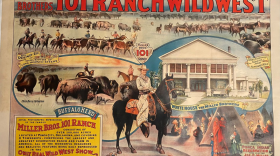Travel in Dakota Territory was not for the faint of heart. People who came out with wagon trains often walked beside their wagons. Metis traders relied on their two-wheeled Red River carts. Fur traders and mountain men walked and canoed from one end of the territory to the other.
On this date in 1905, the Washburn Leader reminded readers of another early form of transportation: the stagecoach. Stagecoach routes crisscrossed the territory until the railroad arrived and the stagecoach faded away.
According to the article, stagecoaches carried passengers and mail beginning in 1868. From 1877 to 1880, a booming stagecoach trade carried travelers to the gold fields of the Black Hills. The route from Bismarck to Deadwood was the most popular as it was the most direct. Since there were no towns along the way, stations were established every twenty miles. Passengers could stretch their legs while a team of fresh horses was harnessed to the stagecoach.
Two famous businessmen with North Dakota ties were involved in the stagecoach business. William Fargo teamed with Henry Wells to form the Wells Fargo Stagecoach Line. They used Concord coaches, recognized as being top of the line and the most comfortable.
The Marquis de Mores ran the Medora Stage Company, which ran between Medora and Deadwood. The journey took thirty-six hours. Today it takes about four and a half hours. The cost for a one-way ticket was $21.50, about ten cents per mile.
The most famous stagecoach was the Deadwood Stage. It often carried gold from the Black Hills. It was attacked by desperadoes with names like Pegleg Bradley and Dunk Blackbird. It was guarded by men with reputations nearly as bad as the highwaymen. On one occasion it was driven by Calamity Jane. It was eventually purchased by Buffalo Bill Cody, who used one of its coaches as a centerpiece of his Wild West show. Audiences thrilled to the reenactment of outlaws galloping after the fleeing stagecoach.
A few historic sites remain today for those who care to look. Bits and pieces of the Abercrombie Trail between St. Paul and Fort Abercrombie can still be found. The Cannonball Station was the fifth stop between Bismarck and Deadwood. Today it is a state historic site, with a water fountain and a picnic table offering hospitality for adventurous travelers looking for history.
Dakota Datebook written by Carole Butcher
Sources:
Washburn Leader. “The old stage line…” Washburn ND. 12/29/1905. Page 5.
North Dakota State Historical Society. “Cannonball Stage Station.” https://www.history.nd.gov/historicsites/cannonballss/index.html Accessed 11/26/20.
ND Studies. “River and Overland Travel.” https://www.ndstudies.gov/gr4/early-settlement-north-dakota/part-1-early-settlement-north-dakota/section-8-river-and-overland Accessed 11/26/20.
Legends of America. “The Deadwood Stage.” https://www.legendsofamerica.com/we-deadwoodstage/ Accessed 11/26/20.
Wells Fargo. “Our Stagecoach Story.” https://www.wellsfargo.com/about/corporate/stagecoach/ Accessed 11/26/20.




